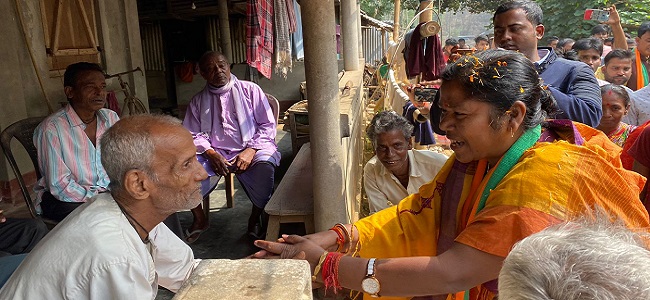Thiruvananthapuram: Molecular biomarkers are useful tools in the prediction, diagnosis, and treatment of cancers to lessen surprises, progression, and suffering, says Dr. Prasanth Ariyannur, Consultant Molecular Laboratory Incharge, Karkinos Healthcare.

Cancer occurs in people without prior notice; Unrelated to any apparent lifestyle or food habits; Diagnosis becoming cumbersome and difficult; Expensive treatment options; Often little to no effect on treatment and progresses no matter what; not to mention the pain, suffering, and death.
Let’s look at each one of them:
A majority of people are diagnosed with cancer unexpectedly. Due to the random nature of the cancer event, it is prudent for all of us to expect cancer to occur in usor anyone close to us. Maybe even a few cases can be predicted too. How?
- A set of cancers occurring in young subjects can be due to genetic changes they may have either inherited from their parents or occurred in their own primordial stem cells randomly. A simple genetic testing can be done to know our risk of getting cancers and be prepared for it in various ways. The life story of the Hollywood actress Angelina Jolie is an example of how early identification of molecular risk can thwart cancer occurrence.
- Certain types of cancers are caused by specific viral infection, e.g., cervical cancer occurring due to Human Papilloma Virus infection. Get tested for HPV viral screening. If the result turns out to be positive, get treatment appropriately.
- After a certain age, usually around 35 years, everyone should be aware of the possibilities of occurrence of some type of cancer. So, watch out for those specific signs that may be shown by our own body.
- People who lead a risky lifestyle with habits, such as smoking, drinking, using pan-masala, or tobacco chewing, must and should be aware of getting cancer ahead of time.
But why is it that certain cancers are not connected to any lifestyle or food habits? Carcinogenic chemicals are added to a lot of food and other consuming substances that are available in the market in higher quantites. Some of the food items we call “junk” food contain the most prevalent carcinogenic agents, such as nitrosamines, are included in our regular “healthy” diet too. These carcinogens may not be present in the food before consumption, instead they may be formed inside the body once it is ingested, digested and absorbed in the cells. In certain situations, the inability for cellular metabolism can cause even harmless food components to turn into a cancer-causing agent. This is dependent on our metabolic capabilities determined by genetic information and other molecular characteristics. This is a major reason for the lack of an apparent connection between lifestyles and occurrences of cancer.
Early detection of cancer would be very helpful in terms of getting effective treatment and avoiding pain and uneasiness associated to the disease and its treatment. Many studies have shown that early detection greatly improves disease-free survival. However early diagnosis is often not done properly due to lack of awareness and availability. There are specific biomarkers presented by our body to give us an early indication of cancer. These can be imaging, tissue and cytologic, and molecular biomarkers. Any of these biomarkers can be tested right now in major cancer hospitals and laboratories across the country. Some of the biomarkers have high diagnostic yield, which means they can help identify the type of cancer. Some other biomarkers can predict whether cancer is aggressive or not. Even some of the biomarkers can provide information regarding treatment. The utility of the best biomarkers in predicting and treating cancers is now implemented in routine medical practice to improve and increase disease free survival.
For almost all types of cancers, the cost of treatment is directly proportional to the stage or aggressiveness of the cancer. For advanced cancers, often multiple types of treatment are needed which can be very expensive. However, the diagnosis of advanced cancers is comparatively cheaper. As mentioned earlier, early detection of biomarkers can help make intelligent decisions of appropriate treatment, which is usually at a lower cost than a desperate later stage treatment which often results in under-utilizing the treatment or failure in achieving good treatment response. This brings us to the next issue of the progression of cancer even under treatment.
For the most part, the current treatment strategies for cancers are highly titrated according to the stage and severity of cancers. For early-stage cancers with a localized tumor, usually, it involves surgical removal of the tumor part. For later-stage cancers, where the tumor has spread beyond the organs, it cannot be surgically removed therefore leading to chemotherapy or radiation therapy depending upon the case so far identified. If none of this work and the tumor progresses, then oftentimes, molecular biomarkers are sought because of the availability of targeted chemotherapy for specific molecular biomarkers which can improve survival chance even in advanced stages. But here also, those targeted chemotherapeutic agents would give better outcomes at early stages than at later stages. This is because of the complex combinations of irreversible molecular changes that occur at later stages of cancer.
When it comes to the pain and suffering associated with the disease, it is most commonly experienced during the later stages of cancer. How can we avoid that? One important thing at this stage also comes from biomarker identifications. An ever-enlarging number of studies and knowledge on molecular biomarkers can help identify the advanced stage of cancers very accurately. The combination of biomarkers changes that are usually identified in late-stage cancers would help to make a better decision of whether it is necessary to go for a curative treatment at all. Often curative attempts at that stage could lead to treatment failures and more complications due to the treatment itself. In this way also, biomarkers can help to make better decisions to reduce more suffering at that stage.






